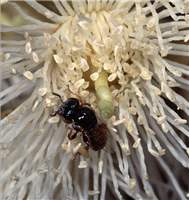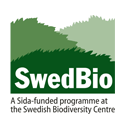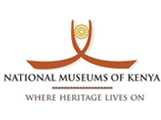Scientific Classification
Species in the Genus
Species in Kenya, Tanzania & Uganda
Description
Possible Causes of Confusion
Distribution in Kenya, Tanzania & Uganda
Habitats
Nesting
Crops Visited
Other Plants Visited
Economic / Ecological Importance
Threats
Conservation and Management Practices
Legislation (National and International)
References
Editors
Acknowledgements
Contact
Click on images to enlarge

Liotrigona mahafalya. © Bernhard Jacobi
Summary
Honey bees are not the only bee species that are significant for human wellbeing. Liotrigona bees (which like a number of groups of bees are known as stingless bees) are a group of native bee species that produce honey and store pollen which is harvestable. However, they have not been domesticated. Liotrigona bees are also important pollinators of crops and wild plants. Their honey and pollen is widely harvested from the wild but in a destructive and non-sustainable manner. They are considerably smaller than honey bees and do not sting. They nest in colonies in small tree cavities but their precise nesting behaviour is poorly known. Liotrigona bees are often confused with the better known stingless bees in the genus Hypotrigona. This fact sheet provides information about these bees to encourage farmers to understand and protect them to help ensure that their crops are effectively pollinated.
From a conservation and agricultural standpoint it is not necessary to recognise all the different bee genera. However, it is important to know that there is a large bee biodiversity. Different bee genera pollinate different plant species, although there is some overlap that acts as a buffer as bee populations wax and wane. For healthy ecosystems, including agro-ecosystems both diversity and abundance in the bee fauna is important.
Common Name (Language)
White-dark stingless bees (English), Kadoma (Luganda –
Scientific Classification
Kingdom: Animalia
Phylum: Arthropoda
Class: Insecta
Order: Hymenoptera
Family: Apidae
Subfamily: Apinae
Tribe: Meliponini
Genus: Liotrigona Moure, 1961
Species in the Genus
The bees in the genus Liotrigona, are small black-white bees in the tribe Meliponini. Eight species from this genus have been named to date. Most of these species are known from
Species in Kenya, Tanzania & Uganda
Very few species of Liotrigona bees occur in
Description
Liotrigona bees belong to the tribe Meliponini (stingless bees) which along with the honey bee (which belong to the tribe Apini) constitute the two highly eusocial bee groups. i.e. bees that live in large colonies of individuals in which there is a division of labour including reproductive queens and sterile workers.
Liotrigona bees are not well known by local people (including farmers) in
In Uganda, these bees are mainly collected in farmlands with a variety of farming systems where there has been recent degradation of the forests. These bees like to follow people who have recently applied body milk. They are commonly trapped in pan traps.
Possible Causes of Confusion
Bees in the genus Hypotrigona can confused with Liotrigona bees but differ in that Liotrigona are generally shinier. Some hoverflies could be mistaken for Liotrigona. Flies can be distinguished from Liotrigona bees as they have only two wings while bees have four wings.
Distribution in Kenya, Tanzania & Uganda
Liotrigona bees are found in some districts/regions of
Habitats
Liotrigona bees can be found in various specific habitats (land-uses) in East Africa such as grasslands, natural forests, wetlands, marshlands, protected areas, farmlands, woodlands, woodlots (forest plantations) and riparian forest areas.
Nesting
These social bees nest in small tree cavities. However, the precise nesting behaviour of these bees in
Crops Visited
Liotrigona bees are rarely seen collecting nectar and pollen from crop species in
Other Plants Visited
Liotrigona bees are rarely seen collecting nectar and pollen from wild plant species in
Economic / Ecological Importance
Little information exists on the usefulness of these bees to the lives of the people in
Threats
In
Conservation and Management Practices
Stingless bees play an important ecological role as pollinators of many wild plant species and seem good candidates for future alternatives in commercial pollination (Slaa et al, 2006). Stingless bees can pollinate most cultivated crops; therefore, their presence nearby fields can be very beneficial to farmers. It is therefore important to manage habitats to conserve these bees.
There have been some attempts in domesticating stingless bees in
Legislation (National and International)
There is not yet any legislation in
References
1. Eardley CD, M Gikungu M.P Schwarz (2009) Bee conservation in Sub-Saharan Africa and
2. Eardley CD, Kuhlmann M and Pauly A. (2010) The Bee Genera and Subgenera of sub-Saharan
3. Eardley CD and R Urban (2010) Catalogue of Afrotropical bees (Hymenoptera: Apoidea: Apiformes). Zootaxa, 2455: 1–548.
4. Michener CD (2007) The Bees of the world, the John Hopkins University Press,
5. Eardley CD (2005) Taxonomic revision of the African stingless bees (Apoidea: Apidae: Apinae: Meliponini), African Plant Protection, 10:64–74.
Editors
Théodore Munyuli, Busitema University - Uganda; Muo Kasina, Kenya Agricultural Research Institute (KARI) - Kenya; Juma Lossini, Tropical Pesticides Research Institute (TPRI) – Tanzania; John Mauremootoo, BioNET-INTERNATIONAL Secretariat – UK; Connal Eardley, Plant Protection Research Institute (PPRI) – South Africa.
Acknowledgements
We recognise the support from the Kenya Agricultural Research Institute (KARI), Tropical Pesticide Research Institute (TPRI) –
Contact
BioNET-EAFRINET regional coordinator: [email protected]












